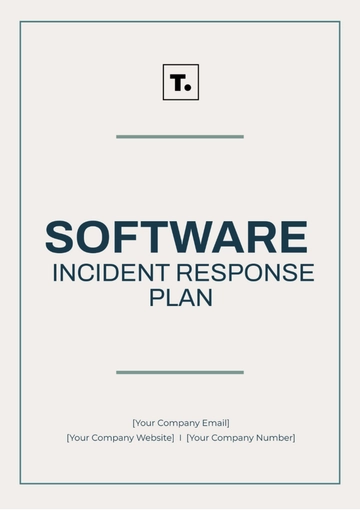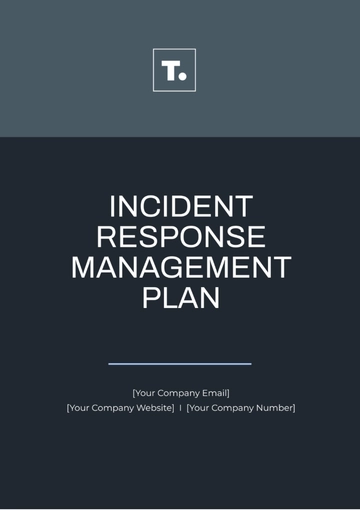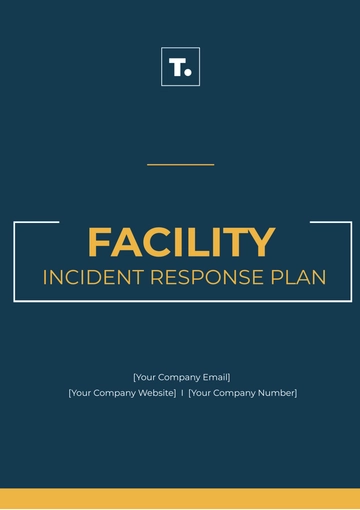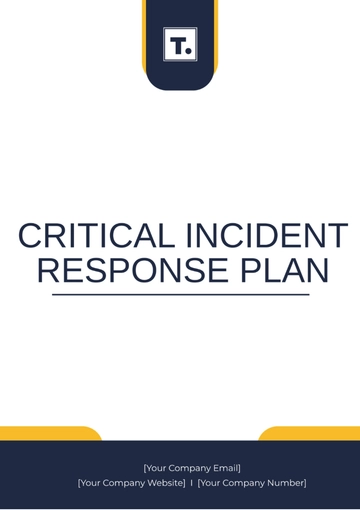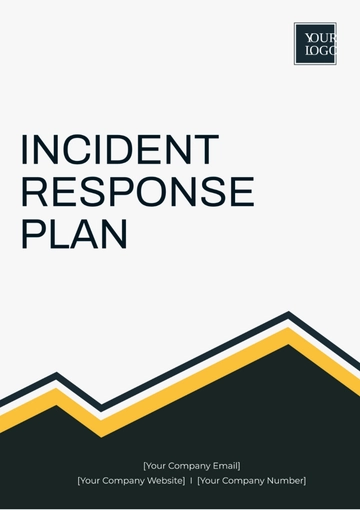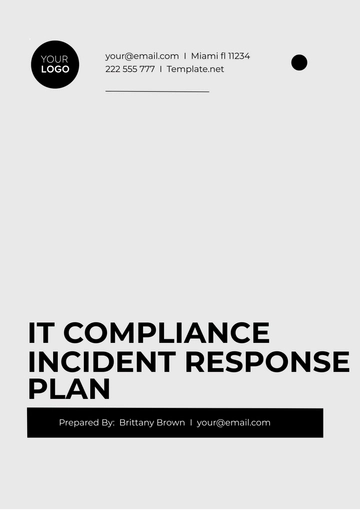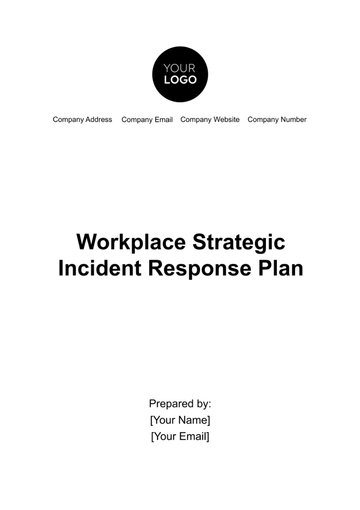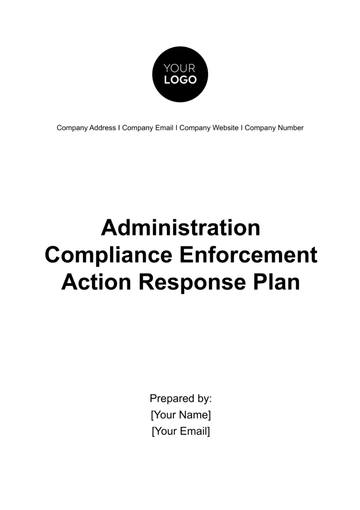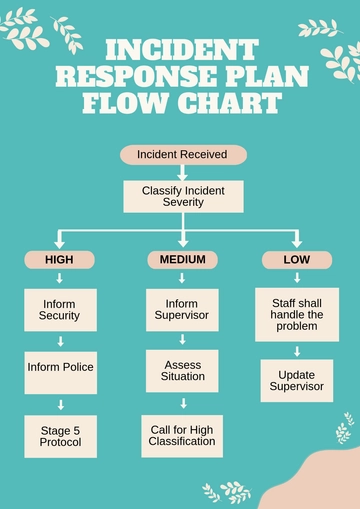Free Security Incident Response Plan

_____________________________________________________________________________________
_____________________________________________________________________________________
I. Introduction and Purpose
The Security Incident Response Plan (SIRP) outlines the procedures and protocols to be followed in the event of a security incident within [Your Company Name]. The primary purpose of this plan is to ensure a swift and coordinated response to security breaches, minimizing their impact on operations, data integrity, and reputation. It aims to protect sensitive information, systems, and assets from unauthorized access, data breaches, malware attacks, and other security threats.
_____________________________________________________________________________________
II. Roles and Responsibilities
Roles | Responsibilities |
|---|---|
Incident Response Team | Comprised of IT security experts, network administrators, and designated personnel responsible for coordinating and executing the response plan. |
Executive Management | Provides support, resources, and decision-making authority during security incidents. |
Legal and Compliance Teams | Ensure response actions align with legal and regulatory requirements. |
All Employees | Required to report any suspicious activity or security incidents promptly. |
_____________________________________________________________________________________
III. Incident Identification and Classification
Detection
Monitoring systems for indicators of compromise (IoCs), abnormal behavior, or unauthorized access.
Reporting
Employees are encouraged to report suspicious activity to the Incident Response Team via designated channels.
Classification
Incidents are categorized based on severity, impact, and type to prioritize response efforts.
_____________________________________________________________________________________
IV. Incident Response Phases
Preparation | Establishing incident response procedures, roles, and communication channels. Conducting regular security awareness training. |
Identification | Detecting and verifying security incidents through monitoring, analysis, and reporting. |
Containment | Isolating affected systems or networks to prevent further damage or unauthorized access. |
Eradication | Removing malicious elements, restoring affected systems to a secure state, and patching vulnerabilities. |
Recovery | Restoring normal operations, data integrity, and system functionality. Conducting post-incident analysis and lessons learned. |
Lessons Learned | Documenting and analyzing the incident response process to improve future response efforts. |
_____________________________________________________________________________________
V. Communication Plan
Internal Communication
Notifying relevant stakeholders, including executive management, IT teams, and employees, about the incident and response actions.
External Communication
Liaising with law enforcement, regulatory agencies, customers, and partners as necessary, while ensuring compliance with legal and regulatory requirements.
_____________________________________________________________________________________
VI. Legal and Regulatory Compliance
Compliance Assessment
Evaluating response actions to ensure alignment with applicable laws, regulations, and industry standards.
Legal Guidance
Seeking legal counsel to navigate legal implications, obligations, and potential liabilities associated with security incidents.
VII. Training and Awareness
Security Awareness Training
Providing regular training sessions to educate employees about security best practices, incident reporting procedures, and their role in maintaining security.
Incident Response Drills
Conduct simulated exercises to test the effectiveness of the response plan and enhance preparedness.
_____________________________________________________________________________________
VIII. Review and Improvement
Continuous Improvement
Regularly reviewing and updating the Security Incident Response Plan based on lessons learned from past incidents, emerging threats, and changes in the organization's environment.
Post-Incident Analysis
Conducting thorough post-mortem analyses of security incidents to identify areas for improvement and refine response procedures.
_____________________________________________________________________________________
- 100% Customizable, free editor
- Access 1 Million+ Templates, photo’s & graphics
- Download or share as a template
- Click and replace photos, graphics, text, backgrounds
- Resize, crop, AI write & more
- Access advanced editor
Ensure swift and effective responses to security incidents with Template.net's Security Incident Response Plan Template. This fully customizable and editable template is designed to fit your specific needs. Effortlessly adjust the details using our Ai Editor Tool to stay prepared for any security threats. Protect your organization with a plan that's both comprehensive and easy to customize.
You may also like
- Finance Plan
- Construction Plan
- Sales Plan
- Development Plan
- Career Plan
- Budget Plan
- HR Plan
- Education Plan
- Transition Plan
- Work Plan
- Training Plan
- Communication Plan
- Operation Plan
- Health And Safety Plan
- Strategy Plan
- Professional Development Plan
- Advertising Plan
- Risk Management Plan
- Restaurant Plan
- School Plan
- Nursing Home Patient Care Plan
- Nursing Care Plan
- Plan Event
- Startup Plan
- Social Media Plan
- Staffing Plan
- Annual Plan
- Content Plan
- Payment Plan
- Implementation Plan
- Hotel Plan
- Workout Plan
- Accounting Plan
- Campaign Plan
- Essay Plan
- 30 60 90 Day Plan
- Research Plan
- Recruitment Plan
- 90 Day Plan
- Quarterly Plan
- Emergency Plan
- 5 Year Plan
- Gym Plan
- Personal Plan
- IT and Software Plan
- Treatment Plan
- Real Estate Plan
- Law Firm Plan
- Healthcare Plan
- Improvement Plan
- Media Plan
- 5 Year Business Plan
- Learning Plan
- Marketing Campaign Plan
- Travel Agency Plan
- Cleaning Services Plan
- Interior Design Plan
- Performance Plan
- PR Plan
- Birth Plan
- Life Plan
- SEO Plan
- Disaster Recovery Plan
- Continuity Plan
- Launch Plan
- Legal Plan
- Behavior Plan
- Performance Improvement Plan
- Salon Plan
- Security Plan
- Security Management Plan
- Employee Development Plan
- Quality Plan
- Service Improvement Plan
- Growth Plan
- Incident Response Plan
- Basketball Plan
- Emergency Action Plan
- Product Launch Plan
- Spa Plan
- Employee Training Plan
- Data Analysis Plan
- Employee Action Plan
- Territory Plan
- Audit Plan
- Classroom Plan
- Activity Plan
- Parenting Plan
- Care Plan
- Project Execution Plan
- Exercise Plan
- Internship Plan
- Software Development Plan
- Continuous Improvement Plan
- Leave Plan
- 90 Day Sales Plan
- Advertising Agency Plan
- Employee Transition Plan
- Smart Action Plan
- Workplace Safety Plan
- Behavior Change Plan
- Contingency Plan
- Continuity of Operations Plan
- Health Plan
- Quality Control Plan
- Self Plan
- Sports Development Plan
- Change Management Plan
- Ecommerce Plan
- Personal Financial Plan
- Process Improvement Plan
- 30-60-90 Day Sales Plan
- Crisis Management Plan
- Engagement Plan
- Execution Plan
- Pandemic Plan
- Quality Assurance Plan
- Service Continuity Plan
- Agile Project Plan
- Fundraising Plan
- Job Transition Plan
- Asset Maintenance Plan
- Maintenance Plan
- Software Test Plan
- Staff Training and Development Plan
- 3 Year Plan
- Brand Activation Plan
- Release Plan
- Resource Plan
- Risk Mitigation Plan
- Teacher Plan
- 30 60 90 Day Plan for New Manager
- Food Safety Plan
- Food Truck Plan
- Hiring Plan
- Quality Management Plan
- Wellness Plan
- Behavior Intervention Plan
- Bonus Plan
- Investment Plan
- Maternity Leave Plan
- Pandemic Response Plan
- Succession Planning
- Coaching Plan
- Configuration Management Plan
- Remote Work Plan
- Self Care Plan
- Teaching Plan
- 100-Day Plan
- HACCP Plan
- Student Plan
- Sustainability Plan
- 30 60 90 Day Plan for Interview
- Access Plan
- Site Specific Safety Plan

